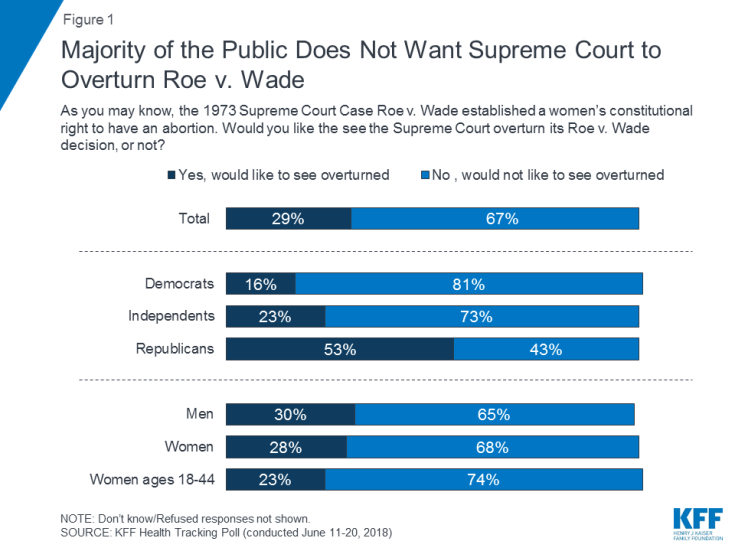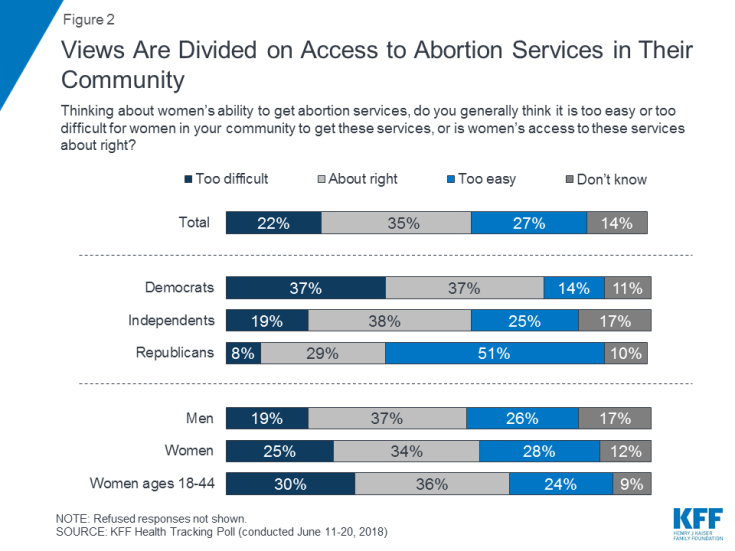Further Findings from Kaiser’s June Health Tracking Poll: Women’s Issues
In light of the #MeToo Movement, recent 2018 primary election wins by female candidates, and Justice Kennedy’s retirement, there has been increased attention to the role of women’s issues in the political process and the courts, including workplace protections and reproductive health issues. The latest Kaiser Health Tracking Poll examined the public’s attitudes towards these issues with a focus on the views of women of reproductive age (ages 18-44).
Key Findings:
- Conducted prior to the announcement of Supreme Court Justice Anthony Kennedy’s retirement, the poll finds two-thirds of the public do not want to see the Supreme Court overturn Roe v. Wade, while three in ten (29 percent) would like to see the decision overturned. A slim majority (53 percent) of Republicans would like to see Roe v. Wade overturned, while large majorities of Democrats (81 percent), independents (73 percent), and women of reproductive age (74 percent) say they would prefer to see Roe v. Wade stay in place.
- Voters are divided along party lines on how a candidate’s position on access to abortion services will influence their vote. Overall, four in ten (42 percent) say they are more likely to vote for a candidate who supports access to abortion services while three in ten (29 percent) say they are more likely to vote for a candidate who wants to restrict access to abortion services. One-fourth of voters say a candidate’s position on this issue does not make a difference in who they will vote for in the fall.
- The Trump Administration recently has proposed changes to rules about federal Title X family planning funding that helps pay for reproductive health care, contraception, and other preventive care services for low-income women. The new rule would prohibit federal family planning funding from going to organizations that also provide abortion services, even if the funds themselves cannot be used to pay for abortions. Over half the public (57 percent) say they oppose the newly proposed rule, while four in ten (38 percent) support it. While majorities of Democrats (67 percent) and independents (55 percent) oppose the new rule, Republicans are more evenly split (46 percent support, 48 percent oppose).
- While few voters (eight percent) say issues affecting women are the “most important issue” for 2018 candidates to discuss, about half (48 percent) say they are “very important but not the most important issue.” When the 56 percent of voters who want to hear candidates talk about women’s issues are asked to say in their own words what issues they specifically want to hear the candidates discuss, four in ten (44 percent) mention issues related to equal pay or fair employment practices. In addition, most voters say they are more likely to vote for a candidate who supports stronger workplace protections against sexual harassment and assault, as well as paid parental leave.
The Public’s Views on Women’s Access to Abortion and Family Planning Services
In light of news about Supreme Court Justice Anthony Kennedy’s impending retirement, many commentators have raised questions about the future of abortion laws in the U.S., and some have questioned whether Roe v. Wade, the 1973 decision establishing women’s constitutional right to abortion, might be overturned if President Trump appoints a more conservative Justice to replace Kennedy. The latest Kaiser Health Tracking Poll, which began collecting data two weeks before Justice Kennedy’s retirement was announced, finds that two-thirds of the public do not want to see the Supreme Court overturn this decision, while three in ten (29 percent) would like to see the decision overturned.
Poll: Two-thirds of Americans Don’t Want the Supreme Court to Overturn Roe v. Wade
While a slim majority (53 percent) of Republicans would like to see Roe v. Wade overturned, large majorities of Democrats (81 percent) and independents (73 percent) do not want the decision overturned. Seven in ten (68 percent) women overall, and three-quarters (74 percent) of women of reproductive age (18-44 years) say they would prefer to see Roe v. Wade stay in place.
Views About CUrrent Access Levels to Abortion Are Largely driven by Partisanship
When it comes to their opinion about women’s current level of access to abortion services in their community, the public is divided, with about a quarter (27 percent) saying it is “too easy” for women to get these services, one in five (22 percent) saying it is “too difficult,” and about a third (35 percent) saying access is “about right.” Democrats (37 percent) are more likely to say it is currently “too difficult” for women to access abortion services in their community, while about half (51 percent) of Republicans say it is “too easy” for women to access these services. Among women between the ages of 18-44 who are the most likely to have direct experience regarding abortion access, three in ten (30 percent) say it is “too difficult,” about a quarter (24 percent) say it is “too easy,” and about a third (36 percent) say access is “about right.”
Most Say Access to Family Planning Services in their community is about right
The public is less divided when it comes to their views about access to family planning services and contraception in their community, with most (55 percent), saying that women’s access to these services is “about right.” Still, more say it is “too difficult” for women in their community to get these services than say it is “too easy” (24 percent versus 12 percent). Among women of reproductive age who are more likely to have direct experience – most (56 percent) say women’s access to family planning services in their community is “about right,” but about one-third (35 percent) say it is “too difficult” to access such services, five times the share who say it is “too easy” (seven percent).
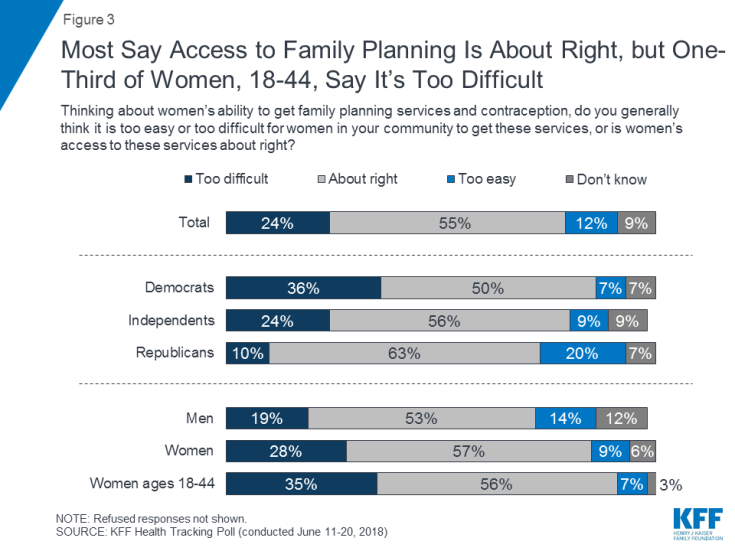
Figure 3: Most Say Access to Family Planning Is About Right, but One-Third of Women, 18-44, Say It’s Too Difficult
Majority of the Public Oppose Trump Administration’s Proposed Changes to Title X Funding
The Trump Administration has recently proposed changes to rules about federal Title X family planning funding that helps pay for reproductive health care, contraception, and other preventive care services for low-income women.1 The proposed rule would require providers that offer abortion care in addition to family planning services to have a “physical separation” and “separate personnel” from other family planning activities in addition to the financial separation requirement already in place. In effect, it means that organizations like Planned Parenthood that provide abortions in addition to other health services will no longer be able to receive Title X funds to serve low-income women. The poll finds that 33 percent of women, including 39 percent of women under the age of 45, say they have visited a Planned Parenthood clinic for health services at some point.
Over half the public (57 percent) say they oppose the proposed rule that would prohibit federal funding from going to organizations that provide abortion services, even if the funds themselves cannot be used to pay for abortions, while four in ten (38 percent) support the proposed rule. While majorities of Democrats (67 percent) and independents (55 percent) oppose the proposed rule, Republicans are more evenly split (46 percent support, 48 percent oppose). Views among men and women (including women of reproductive age) are similar, with about four in ten of each group in support and about six in ten opposed.
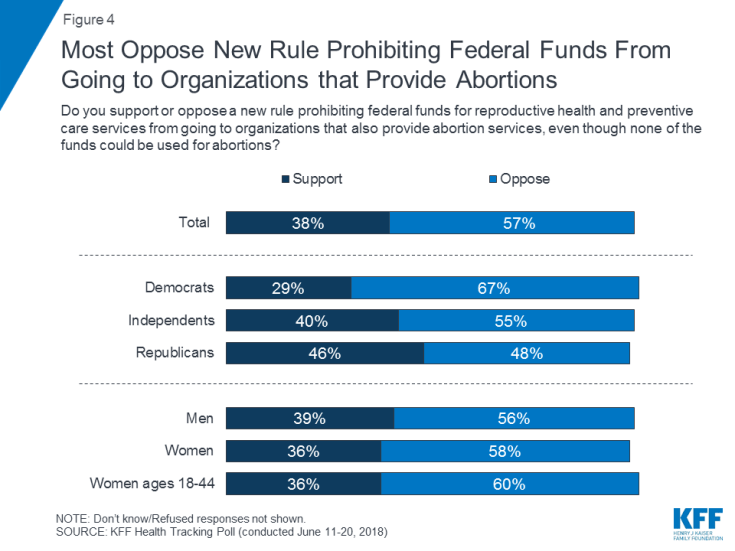
Figure 4: Most Oppose New Rule Prohibiting Federal Funds From Going to Organizations that Provide Abortions
Majority of the Public Supports COntinued Federal Funding for Reproductive Health Care Services for Low-Income Women
More broadly, the poll finds strong support for federal government funding for reproductive health services for low-income women. Eight in ten adults say it is either “very important” (57 percent) or “somewhat important” (23 percent) to them that the federal government provides funding for services like family planning and birth control for low-income women. Support differs somewhat by party identification, with Democrats (79 percent) more than twice as likely as Republicans (31 percent) to say such funding is “very important.” Still, a majority (59 percent) of Republicans say this funding is at least “somewhat important.” Support also differs by gender, with about half of men (47 percent) and two-thirds of women saying it is “very important” to them that the federal government provides funding for reproductive health services for low-income women, rising to almost three-quarters (73 percent) among women ages 18-44.
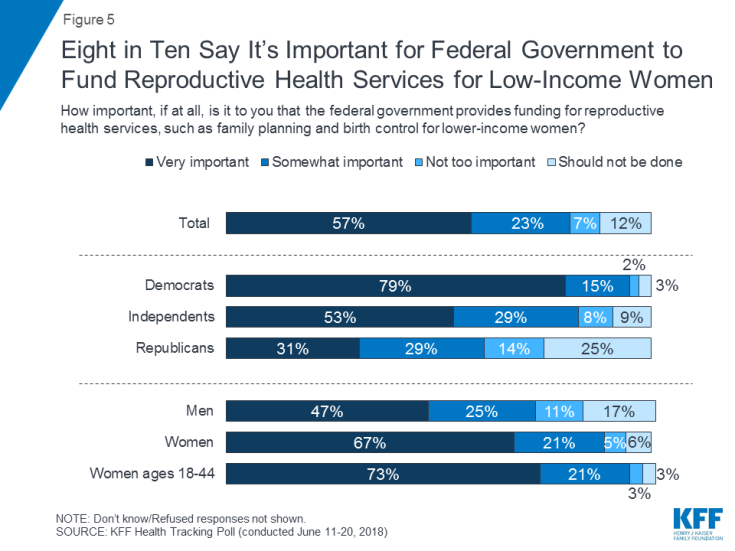
Figure 5: Eight in Ten Say It’s Important for Federal Government to Fund Reproductive Health Services for Low-Income Women
The Role of Women’s Issues in the 2018 Campaigns
While few voters say that issues that mainly affect women are the top issue for 2018 candidates to talk about, the latest Kaiser Health Tracking Poll finds large shares of voters saying a candidate’s stance on key women’s issues will make a difference in who they vote for this fall.
Few voters (eight percent) say issues affecting women are the “most important issue” for 2018 candidates to discuss during their campaigns. Larger shares of voters say health care (25 percent), the economy and jobs (23 percent), gun policy (20 percent), immigration (18 percent), and foreign policy (13 percent) are the “most important issue” for candidates to talk about.
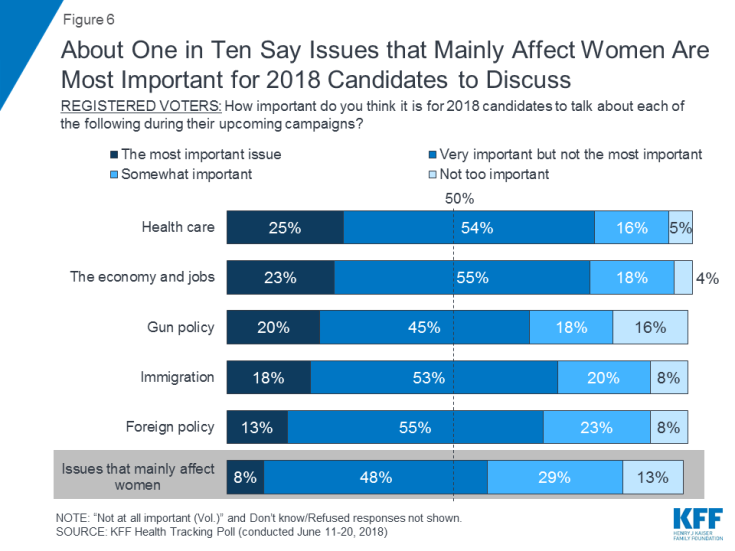
Figure 6: About One in Ten Say Issues that Mainly Affect Women Are Most Important for 2018 Candidates to Discuss
A larger share of Democratic voters (15 percent) say issues that mainly affect women are the “most important issue” for 2018 candidates to discuss compared to six percent of independent voters and four percent of Republican voters. Women voters (10 percent), and women voters under the age of 45 (12 percent), are more likely than men voters (six percent) to say that issues affecting women are the “most important issue” for the 2018 candidates to talk about.
Equal Pay and Fair Employment Practices Are Top Women’s Issues for Voters
When the 56 percent of voters who say it is important for candidates to talk about women’s issues are asked to say in their own words what issues they specifically want to hear the candidates discuss, four in ten (44 percent, or 25 percent of all voters) mention issues related to equal pay or fair employment practices. This is twice as many as mention reproductive health issues including abortion or contraception (20 percent, or 11 percent of all voters) or general mentions of equality or equal rights (18 percent, 10 percent). Fewer – about one in ten – mention issues surrounding sexual harassment or sexual assault (12 percent, seven percent) or women’s health issues such as breast cancer or cancer screenings (11 percent, six percent).
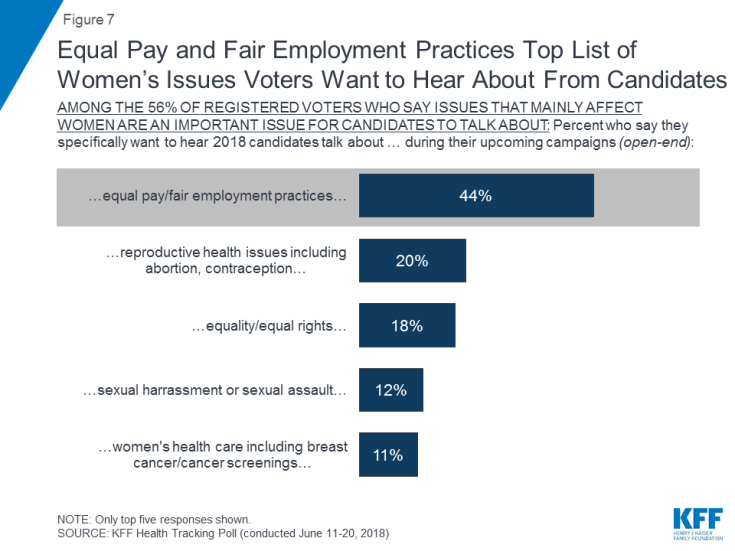
Figure 7: Equal Pay and Fair Employment Practices Top List of Women’s Issues Voters Want to Hear About From Candidates
Candidates’ Stances on Key Women’s Issues Could Play Role in 2018 Vote Choice
While issues mainly affecting women do not necessarily top the list of things voters want to hear candidates talk about, many voters say candidates’ stances on certain issues may play a role in how they vote. For example, six in ten voters say they are more likely to vote for a candidate who wants to enact stronger workplace protections, such as harsher penalties for sexual harassment and assault in the workplace, while just seven percent say they are more likely to vote for a candidate who does not want to enact stronger workplace protections.
Similarly, 53 percent of voters say they are more likely to vote for a candidate who supports a law requiring employers to provide paid parental leave while seven percent of voters say they are more likely to vote for a candidate who does not support a law requiring employers to do this. Half of voters (49 percent) also say they are more likely to support a candidate who is a strong supporter of the #MeToo Movement, the international movement working to raise awareness about sexual harassment and assault, while few (seven percent) say they are more likely to vote for a candidate who does not address issues raised by the movement. At least three in ten voters – across all of these issues – say a candidate’s position on these issues will not make a difference in who they vote for in the fall.
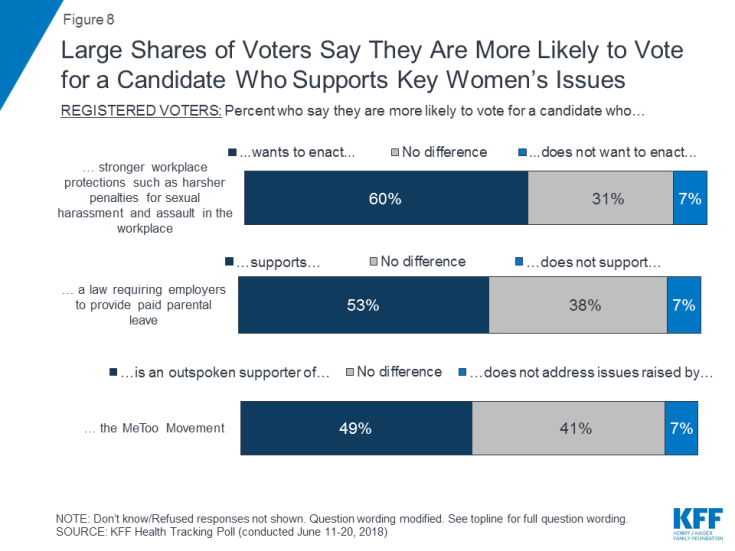
Figure 8: Large Shares of Voters Say They Are More Likely to Vote for a Candidate Who Supports Key Women’s Issues
Majorities of Democratic voters, and about half of independent voters and Republican voters, say they are more likely to vote for a candidate who wants to enact stronger workplace protections such as harsher penalties for sexual harassment and assault in the workplace (76 percent, 54 percent, and 48 percent, respectively). Similarly, most Democratic voters (73 percent) and half of independent voters (47 percent) say they are more likely to vote for a candidate who supports a law requiring paid parental leave. About one-third of Republican voters (34 percent) say the same. Majorities of women voters and at least seven in ten women voters under age 45 also say they are more likely to vote for candidates who support both of these workplace protections.
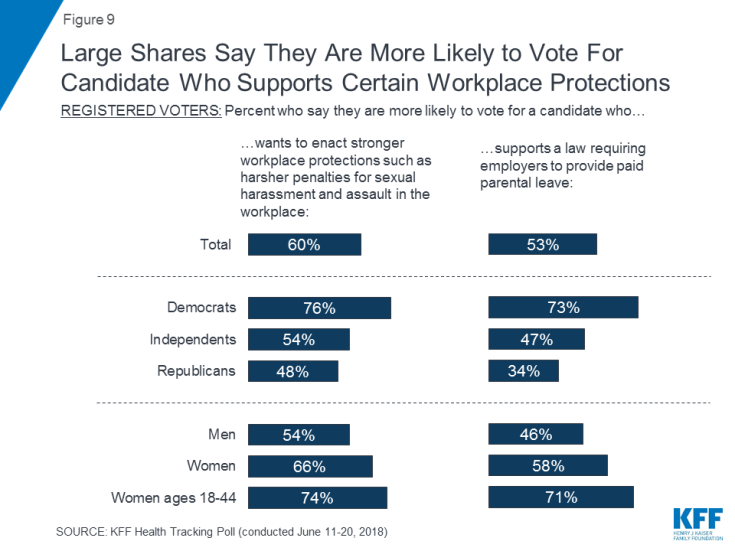
Figure 9: Large Shares Say They Are More Likely to Vote For Candidate Who Supports Certain Workplace Protections
Majorities of Democratic voters (74 percent) and women voters (54 percent), especially those under the age of 45 (62 percent), say they are more likely to vote for a candidate who is an outspoken supporter of the #MeToo movement, while most Republican voters (63 percent) say a candidate’s position on this issue does not make a difference in who they will vote for.
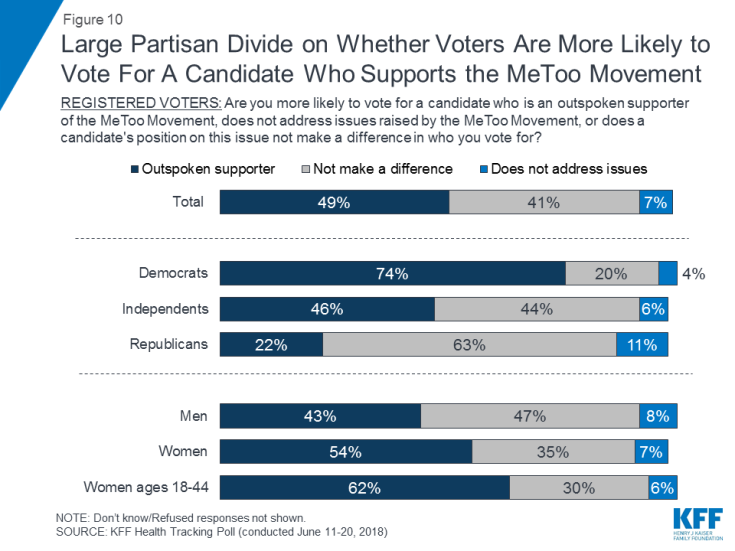
Figure 10: Large Partisan Divide on Whether Voters Are More Likely to Vote For A Candidate Who Supports the MeToo Movement
Voters Are Divided on Party Lines on How a Candidate’s Position on Access to Abortion May Impact Their Vote
Overall, four in ten (42 percent) say they are more likely to vote for a candidate who supports access to abortion services while three in ten (29 percent) say they are more likely to vote for a candidate who wants to restrict access to abortion services. One-fourth of voters (26 percent) say a candidate’s position on this issue does not make a difference in who they vote for in the fall.
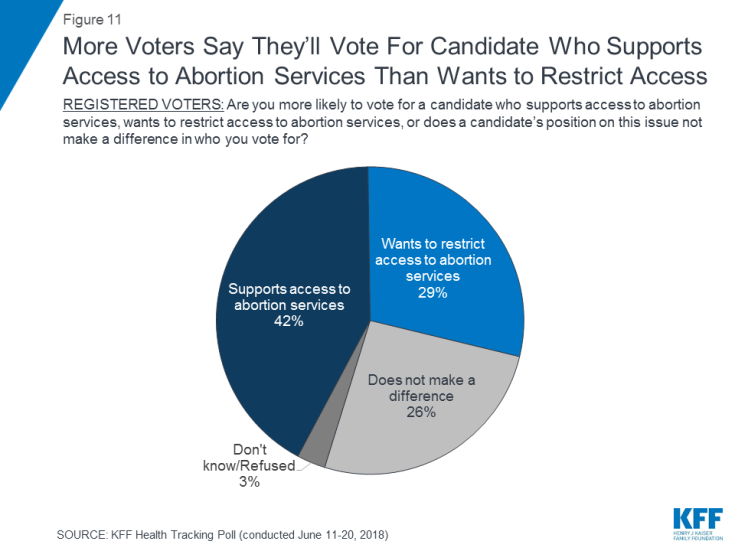
Figure 11: More Voters Say They’ll Vote For Candidate Who Supports Access to Abortion Services Than Wants to Restrict Access
Similar to views on other abortion issues, these attitudes largely fall along party lines with large shares of Democratic voters saying they are more likely to vote for a candidate who supports access to abortion services (72 percent), while six in ten (58 percent) of Republican voters say they are more likely to vote for a candidate who wants to restrict access to abortion services. A larger share of independent voters say they are more likely to vote for a candidate who supports access (39 percent) than for a candidate who wants to restrict access (20 percent). Among women voters under the age of 45, more than twice as many say they are more likely to vote for a candidate who supports access (57 percent) than a candidate who wants to restrict access (25 percent) to abortion services.
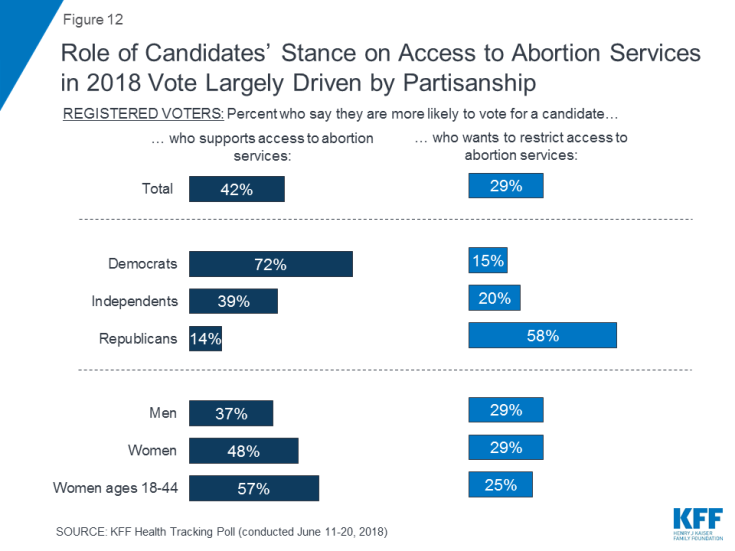
Figure 12: Role of Candidates’ Stance on Access to Abortion Services in 2018 Vote Largely Driven by Partisanship
While party identification appears to be a bigger driver than gender in voters’ attitudes on these issues, there are some differences between women voters and men voters within parties on how a candidate’s position on women’s issues may influence their vote. For example, while majorities of both women and men Democratic voters say they are more likely to vote for a candidate who supports access to abortion services, the share is somewhat larger among women than men (77 percent compared to 63 percent). Among independent voters, a larger share of women than men say they are more likely to vote for a candidate who wants to enact stronger workplace protections (61 percent compared to 47 percent). In addition, among Republican and independent voters, a larger share of women than men say they are more likely to vote for a candidate who is an outspoken supporter of the #MeToo movement.
| Table 1: Role of Women’s Issues for Voters in the 2018 Campaigns | ||||||
| Percent who say they are more likely to vote for a candidate who … | Democratic Voters | Independent Voters | Republican Voters | |||
| Women | Men | Women | Men | Women | Men | |
| …supports access to abortion services | 77% | 63% | 45% | 34% | 11% | 16% |
| …supports a law requiring employers to provide paid parental leave | 76 | 69 | 51 | 42 | 38 | 30 |
| …wants to enact stronger workplace protections | 80 | 71 | 61 | 47 | 52 | 45 |
| …is an outspoken supporter of the #MeToo Movement | 74 | 74 | 55 | 39 | 28 | 16 |

